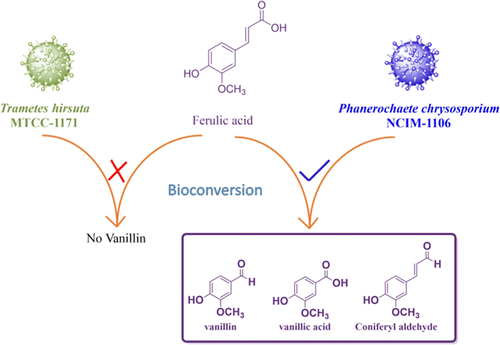Our official English website, www.x-mol.net, welcomes your feedback! (Note: you will need to create a separate account there.)
Comparative Studies of White-Rot Fungal Strains (Trametes hirsuta MTCC-1171 and Phanerochaete chrysosporium NCIM-1106) for Effective Degradation and Bioconversion of Ferulic Acid
ACS Omega ( IF 3.7 ) Pub Date : 2018-11-05 00:00:00 , DOI: 10.1021/acsomega.8b01614 Pravin D. Patil 1 , Ganapati D. Yadav 1
ACS Omega ( IF 3.7 ) Pub Date : 2018-11-05 00:00:00 , DOI: 10.1021/acsomega.8b01614 Pravin D. Patil 1 , Ganapati D. Yadav 1
Affiliation

|
Biodegradation of ferulic acid, by two white-rot fungal strains (Trametes hirsuta MTCC-1171 and Phanerochaete chrysosporium NCIM-1106) was investigated in this study. Both strains could use ferulic acid as a sole carbon source when provided with basal mineral salt medium. T. hirsuta achieved complete degradation of ferulic acid (350 mg L–1) in 20 h, whereas P. chrysosporium degraded it (250 mg L–1) in 28 h. The metabolites produced during degradation were distinguished by gas chromatography–mass spectrometry. Bioconversion of ferulic acid to vanillin by P. chrysosporium was also investigated. The optimum experimental conditions for bioconversion to vanillin can be summarized as follows: ferulic acid concentration 250 mg L–1, temperature 35 °C, initial pH 5.0, mycelial inoculum 0.32 ± 0.01 g L–1 dry weight, and shaking speed 150 rpm. At optimized conditions, the maximum molar yield obtained was 3.4 ± 0.1%, after 20 h of bioconversion. Considering that the degradation of ferulic acid was determined by laccase and lignin peroxidase to some extent, the possible role of ligninolytic enzymes in overall bioconversion process was also studied. These results illustrate that both strains have the potential of utilizing ferulic acid as a sole carbon source. Moreover, P. chrysosporium can also be explored for its ability to transform ferulic acid into value-added products.
中文翻译:

白腐真菌菌株比较研究(栓毛MTCC-1171和白腐菌阿魏酸的NCIM-1106)为有效降解生物转化和
在本研究中,研究了两种白腐真菌菌株(Trametes hirsuta MTCC-1171和Phanerochaete chrysosporium NCIM-1106)对阿魏酸的生物降解作用。当提供基础矿物盐培养基时,两种菌株都可以使用阿魏酸作为唯一的碳源。hirsuta T. hirsuta在20 h内就完全降解了阿魏酸(350 mg L –1),而chrysosporium在28 h内将其降解了(250 mg L –1)。降解过程中产生的代谢产物通过气相色谱-质谱法进行区分。金黄色葡萄球菌将阿魏酸生物转化为香兰素还进行了调查。生物转化为香草醛的最佳实验条件总结如下:阿魏酸浓度250 mg L –1,温度35°C,初始pH 5.0,菌丝体接种量0.32±0.01 g L –1干重,振荡速度150 rpm。在最佳条件下,生物转化20小时后,获得的最大摩尔产率为3.4±0.1%。考虑到漆酶和木质素过氧化物酶在一定程度上决定了阿魏酸的降解,还研究了木质素分解酶在整个生物转化过程中的可能作用。这些结果表明,两种菌株均具有利用阿魏酸作为唯一碳源的潜力。此外,金黄色葡萄球菌 还可以探索其将阿魏酸转化为增值产品的能力。
更新日期:2018-11-05
中文翻译:

白腐真菌菌株比较研究(栓毛MTCC-1171和白腐菌阿魏酸的NCIM-1106)为有效降解生物转化和
在本研究中,研究了两种白腐真菌菌株(Trametes hirsuta MTCC-1171和Phanerochaete chrysosporium NCIM-1106)对阿魏酸的生物降解作用。当提供基础矿物盐培养基时,两种菌株都可以使用阿魏酸作为唯一的碳源。hirsuta T. hirsuta在20 h内就完全降解了阿魏酸(350 mg L –1),而chrysosporium在28 h内将其降解了(250 mg L –1)。降解过程中产生的代谢产物通过气相色谱-质谱法进行区分。金黄色葡萄球菌将阿魏酸生物转化为香兰素还进行了调查。生物转化为香草醛的最佳实验条件总结如下:阿魏酸浓度250 mg L –1,温度35°C,初始pH 5.0,菌丝体接种量0.32±0.01 g L –1干重,振荡速度150 rpm。在最佳条件下,生物转化20小时后,获得的最大摩尔产率为3.4±0.1%。考虑到漆酶和木质素过氧化物酶在一定程度上决定了阿魏酸的降解,还研究了木质素分解酶在整个生物转化过程中的可能作用。这些结果表明,两种菌株均具有利用阿魏酸作为唯一碳源的潜力。此外,金黄色葡萄球菌 还可以探索其将阿魏酸转化为增值产品的能力。







































 京公网安备 11010802027423号
京公网安备 11010802027423号